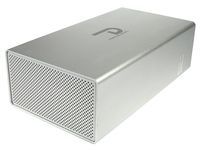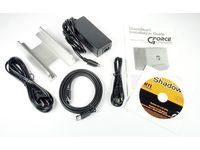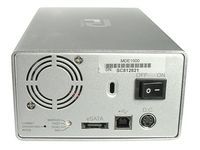Comparing External RAID Housings
Fantom Drives G-Force Megadisk MDE1000
The G-Force Megadisk MDE1000 from Fantom Drives is the only device in our test that already contains two drives. According to the manufacturer, the drives each have a 32 MB cache and operate at a spindle speed of 7200 RPM. The drives fitted in our test device are from Hitachi, and have a capacity of 500 GB each. The G-Force Megadisk MDE1000 costs in the vicinity of $290.

The Package
The scope of delivery includes quick installation instructions, USB and eSATA cables, the NTI Shadow Backup software, a stand, and the external power supply with connection cable. The rear of the housing offers USB and eSATA interfaces as well as the power connection, above which is a toggle switch that can be used to turn the device off.
Since the power supply is not built-in and the power supply switch is secondary, the device still requires approximately 1 watt of power even when switched off. The measured maximum power consumption was 17 watts during the process of setting up the drives with RAID 1. In idle mode, it required approximately 12 watts.

Selecting The Operating Mode
Setting the operating mode is accomplished by using a small rotating button located to the left of the eSATA connection. A small screwdriver is required to turn the button, but is not included in the package. Once you have selected the operating mode, this must be confirmed by pressing a small button located to the left of the switch. You do not need special tools to do this—you can use a ballpoint pen or a paper clip.

The modes available are Mirror, Fast, Dual and Big Mirror. The last of these describes RAID 1, which mirrors the contents of one disk onto the second. The capacity available for use in this mode is 500 GB. The Fast mode is equivalent to RAID 0, where accesses to the disks are carried out in parallel and the data distributed to both disks in identically-sized blocks. This increases the transfer rates, but the RAID 0 mode does not offer any redundancy. The overall capacity in Fast mode is 1000 GB.
Stay on the Cutting Edge
Join the experts who read Tom's Hardware for the inside track on enthusiast PC tech news — and have for over 25 years. We'll send breaking news and in-depth reviews of CPUs, GPUs, AI, maker hardware and more straight to your inbox.
In Dual mode, the user also has 1000 GB of storage available. Here, the operating system considers the two disks to be independent devices. Users will see two 500 GB drives in their Windows Explorer. In the Mirror, Fast and Big modes, both drives are "switched together" and the operating system considers them to be a single drive.
Current page: Fantom Drives G-Force Megadisk MDE1000
Prev Page NAS, DAS, Or What? Next Page SansDigital Mobilestor MS2UTN+-
Aragorn Did anyone else think that the thumbnails of the charts were utterly useless. Why don't we get nicely sized images in THG reports anymore?Reply -
Discussion about external desktop storage and no mention whatsoever of Firewire? *yawn* call me when you have a serious storage article. Firewire is the defacto standard in the pro desktop market, and also of course with all Apple systems. It's faster than USB 2.0 in every benchmark. It's more flexible and mature than eSata. And with Firewire 3.2 Gb/s coming later this year, it's about to get reeeeally fast. I have five external disks (including 2 raid arrays) and all are Firewire 800 connected.Reply
-
hawler I wish firewire would just die with the upcoming release of USB 3.0 which will be fast 4GB/s and more common. It really is annoying to have both of these on a computer when you could simply have just one of them. Id rather have 10 USB slots then 8 USB and two firewire on my computer. I knwo this isn't goign to happen but there simply is no need to have both, I realize currently it is faster but it won't be soon, and when it was first made they should have tried to make it a new version of USB so that there wouldn't be 2 standards.Reply
Thats just my opinion on it, im sure people who use a lot of firewire products (i only use it for my ext HDDs but) might disagree but the idea of having just one I/O choice to me is better...its like display port for monitors...why oh why didn't they just leave it with DVI/HDMI -
@ hawler: USB is NOT a replacement for firewire! There's a reason that ALL pro audio equipment uses Firewire instead of USB. There's a reason that ALL camcorders can stream video only over Firewire and not USB.Reply
It's called "Isochronous transfers". Critical when you're dealing with real-time audio or video. USB doesn't provide that. Also makes bulk data transfer (like backups, for instance) perform more consistently.
USB was never designed for bulk data transfer. That's why it sucks so badly at it. Ever wondered why a 480 Mbit USB2 connection (That's 60 MB/s) can barely achieve between 35 MB/s in real world transfers? That's because the protocol sucks at bulk data transfer. USB was designed for keyboards and mice. To replace low-speed serial ports. Not for high speed bulk data transfer. The USB protocol is inherently deficient in this regard.
Firewire, on the other hand, was designed *specifically* for bulk data transfers. It's obvious when you look at its efficiency at these kinds of tasks. Firewire 400 (that's 50 MB/s) achieves around 42 to 45 MB/s in real world performance. Far FAR more efficient than USB at moving data.
My vote would be for ALL external data storage, audio, and video devices to be firewire only. Make everything else USB. -
njalterio For those of you asking about firewire, many companies do not like to use firewire because of security issues. Firewire devices communicate through direct memory access. There is no operating system intervention. This is why many companies will have their IT staff remove firewire expansion cards or disable them.Reply -
@ njalterio: Companies? IT departments? What kind of company IT department directs their employees to backup the PC's individually using external disks??Reply
Firewire does indeed use DMA. That's another advantage it has over USB, at least in terms of performance. Everyone knows from back in the PATA disk days, that DMA transfers are way faster than non-DMA transfers.
But for professional audio/video, there is only one option and that's Firewire. No such thing as pro a/v products that use USB. They just don't exist. So when you say that "companies disable fw interfaces" I suppose it depends on what sort of company you're talking about. Not a production studio that's for sure!! -
xxsk8er101xx There is this program called Hotswap 4.0.1 i think it is. or maybe 4.1.1. I forget. But it's called Hotswap and it allows you to have that add/remove icon for harddrives. It works for cd-roms, ide drives, fixed drives ... it's an amazing program and best of all - it's free!Reply
Again it's hotswap! 4.'something ... http://www.softpedia.com/get/System/OS-Enhancements/HotSwap.shtml it's an amazing tool and it works very well. Solves the problem listed on page 1 about no add/remove icon. -
GreenPower All my applications are installed on the C drive, which is a 500GB $79 WD unit. I buy a second identical drive and hook it up to an extra 18" sata cable and power right at the edge of the pc case chassis.Reply
I use Acronis True Image disk utility to make and exact copy when the system half way reboots. Then I turn off the power and swap disks. A few applications like Photoshop can still detect they have been copied. But besides this its a 5 minute replacement if my HD ever gets corrupted.
Otherwise it takes about 4 LONG days to rebuild the system from scratch.
Five minutes vs four days. Go figure! -
GreenPower Always run the long format and surface scan any new disk to check for bad sectors. Then re-scan it after its been copied and re-booted with. Only then can you state that you backup is worthy.Reply
Most Popular


